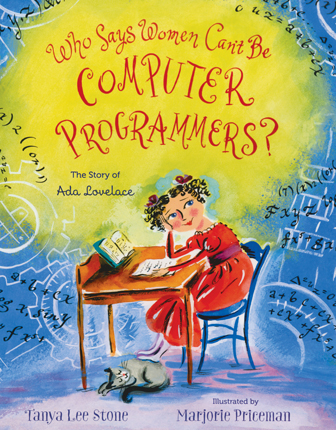| Who says women can't be computer programmers? : the story of Ada Lovelace Author: Stone, Tanya Lee | ||
| Price: $6.50 | ||
Summary:
Known as "The Enchantress of Numbers" by many inventors and mathematicians of the 19th century, Ada Lovelace is recognized today as history's first computer programmer. Her work was an inspiration to such famous minds as Charles Babbage and Alan Turing. This is her story.
| Illustrator: | Priceman, Marjorie |
| Accelerated Reader Information: Interest Level: LG Reading Level: 5.70 Points: .5 Quiz: 500431 |
Reviews:
School Library Journal (02/01/18)
Booklist (01/01/18)
The Hornbook (00/07/18)
Full Text Reviews:
Booklist - 01/01/2018 “It’s excruciating to leave certain details out,” Stone laments in an appended note, but this large-format picture book covers a great deal of territory in 40 fully illustrated pages. Ada lived a complicated, sheltered childhood. Though expected to become a nineteenth-century English lady, she was extensively educated in mathematics. Later, she befriended scientist Charles Babbage, and they frequently discussed ideas for the Difference Engine (a mechanical calculator prototype) and his never-achieved plan for the Analytical Engine, a mechanical computer. Her notes on the Analytical Engine have led to her recognition as a forerunner of computer programming. It’s hard to know what primary-grade children will make of the story, as they will probably know little of Lord Byron (Ada’s father, whom she never met), Charles Babbage, or the history of computers. Still, the story will sweep them along, illuminated by Priceman’s imaginative gouache-and-ink artwork, full of energy, swirling lines, and whimsy. A colorful picture-book biography of the Englishwoman variously known as Augusta Ada Gordon, Ada Byron, Ada Lovelace, and Augusta Ada King, Countess of Lovelace. - Copyright 2018 Booklist.
School Library Journal - 02/01/2018 Gr 3–5—Joining the growing collection of biographies highlighting women in STEM careers, this charming, informative picture book provides young readers with a brief, lively introduction to Ada Byron Lovelace, whose interests and complex ideas were ahead of her 19th century reality. Lovelace was the child of gifted but scandalous English poet, Lord Byron, and his high society, mathematician wife. When Lord Byron abandoned the family, Lovelace's determined, educated mother made sure the child was well-tutored in science, math and social norms rather than imagination and fancy. But, Lovelace's creativity and passion were irrepressible. She befriended polymath, Charles Babbage, whose inventions intrigued her. Babbage envisioned an Analytical Engine, modeled on the Jacquard Loom for textiles, using punch cards for processing numbers instead of threads. Lovelace devised additional Analytic Engine algorithms that could also create pictures and music, "just as computers do today!" An addendum provides more historical details on Lovelace's marriage, her fragile health, her connection with leading scientists of the time, her long friendship with Babbage, and her name changes. On every page, the gouache and India ink artwork offers a vivid, energetic depiction of people, events, and swirling ideas. The art meshes smoothly with the conversational storytelling, capturing the exuberance, elegance, and giftedness of this exceptional woman. VERDICT This appealing picture book will spark immense pride and prompt readers to do their own investigations into the world of mathematics and computers.—Gerry Larson, formerly at Durham School of the Arts, NC - Copyright 2018 Publishers Weekly, Library Journal and/or School Library Journal used with permission.



